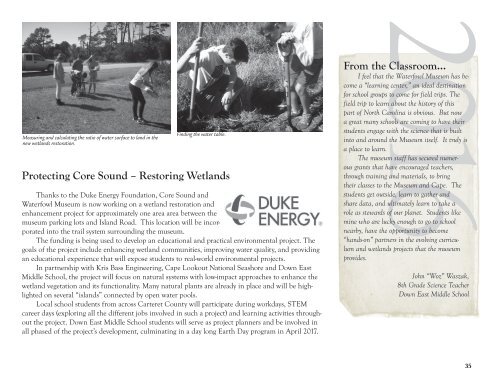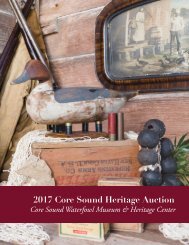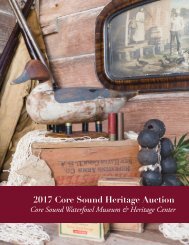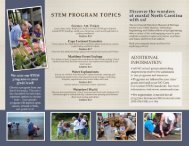504633_AnnualReportTXT_FINAL
You also want an ePaper? Increase the reach of your titles
YUMPU automatically turns print PDFs into web optimized ePapers that Google loves.
Measuring and calculating the ratio of water surface to land in the<br />
new wetlands restoration.<br />
Finding the water table.<br />
Protecting Core Sound – Restoring Wetlands<br />
Thanks to the Duke Energy Foundation, Core Sound and<br />
Waterfowl Museum is now working on a wetland restoration and<br />
enhancement project for approximately one area area between the<br />
museum parking lots and Island Road. This location will be incorporated<br />
into the trail system surrounding the museum.<br />
The funding is being used to develop an educational and practical environmental project. The<br />
goals of the project include enhancing wetland communities, improving water quality, and providing<br />
an educational experience that will expose students to real-world environmental projects.<br />
In partnership with Kris Bass Engineering, Cape Lookout National Seashore and Down East<br />
Middle School, the project will focus on natural systems with low-impact approaches to enhance the<br />
wetland vegetation and its functionality. Many natural plants are already in place and will be highlighted<br />
on several “islands” connected by open water pools.<br />
Local school students from across Carteret County will participate during workdays, STEM<br />
career days (exploring all the different jobs involved in such a project) and learning activities throughout<br />
the project. Down East Middle School students will serve as project planners and be involved in<br />
all phased of the project’s development, culminating in a day long Earth Day program in April 2017.<br />
From the Classroom…<br />
I feel that the Waterfowl Museum has become<br />
a “learning center,” an ideal destination<br />
for school groups to come for field trips. The<br />
field trip to learn about the history of this<br />
part of North Carolina is obvious. But now<br />
a great many schools are coming to have their<br />
students engage with the science that is built<br />
into and around the Museum itself. It truly is<br />
a place to learn.<br />
The museum staff has secured numerous<br />
grants that have encouraged teachers,<br />
through training and materials, to bring<br />
their classes to the Museum and Cape. The<br />
students get outside, learn to gather and<br />
share data, and ultimately learn to take a<br />
role as stewards of our planet. Students like<br />
mine who are lucky enough to go to school<br />
nearby, have the opportunity to become<br />
“hands-on” partners in the evolving curriculum<br />
and wetlands projects that the museum<br />
provides.<br />
John “Woz” Waszak,<br />
8th Grade Science Teacher<br />
Down East Middle School<br />
35






